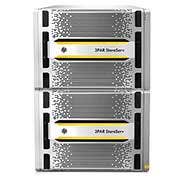HP Targets Enterprise Flash Storage With $1.50-Per-GB Pricing

Hewlett-Packard this week introduced new SSDs that it said will drive the cost of the all-flash version of its 3Par StoreServ arrays to as low as $1.50 per GB.
Palo Alto, Calif.-based HP also introduced a new family of 3Par arrays, the StoreServ 20000 series, that scales to up to eight controllers with up to 3.2 million IOPS performance.
The new additions to the HP 3Par StoreServ line, unveiled this week at the HP Discover conference in Las Vegas, come about a year after HP first introduced 3Par 7000-series flash arrays priced at about $2 per GB, said Craig Nunes, vice president of worldwide marketing for HP storage.
[Related: HP 3PAR Gets Integrated Block, File, Object Storage With Single User Interface]
"That price drove a hockey-stick adoption of flash," Nunes told CRN. "HP today ships about four times as much flash storage capacity than we do high-speed 15,000-rpm disk capacity. "We now feel all-flash arrays are a part of companies' plans. Solutions are now leading with all-flash storage before hybrid flash-disk storage."
The new $1.50-per-GB pricing will help HP and its partners compete against startups such as Newark, Calif.-based Tegile or Newton, Mass.-based Kaminario, said Mike Vencel, senior vice president at Comport Technology Solutions, a Ramsey, N.J.-based solution provider and HP channel partner.
"HP now competes not only against the larger competitors, but also against the smaller companies nipping at our ankles," Vencel told CRN. "There's a place in the market for the smaller players, and they will take some market share. But I'm not sure there's an end-game for them. It's hard to compete when you have a single product."
The introduction of the new lower-cost SSDs will drive higher-density flash storage at attractive pricing, said Dave Butler, president of Enterprise Computing Solutions, a Mission Viejo, Calif.-based solution provider and longtime HP channel partner.
"This will cause customers to think, 'Why do I even need disk?' " Butler told CRN. "In the past, flash was seen as a more costly offering. HP is changing the paradigm."
Manwhile HP's new family of 3Par StoreServ 20000 arrays includes the StoreServ 20850, which is an all-flash array, and the StoreServ 20800, which is a flash-first array with the option to add spinning disk as needed, he said.
The StoreServ 20000 arrays scale to up to eight controllers in a single system capable of operating at 3.2 million IOPS. The StoreServ 20850 supports up to 3.9 PB of raw flash storage using 1,024 SSDs, while the StoreServ 20800 supports up to 6.0 PB of flash and spinning disk, he said.
With compression, the StoreServ 20850 can be configured with up to 5.5 PB in a single rack, Nunes said. "This is industry-leading performance, scalability and density in one system," he said.
A lot of all-flash arrays can be configured with 20 TB or 30 TB of capacity, which can be a challenge when trying to replace 400 TB of enterprise capacity with flash storage, Nunes said.
"You end up with 'flash array sprawl,' " he said. "A platform like this makes it possible to bring flash into data-center-scale deployments."
The growth in flash storage is huge, Comport Technology Solutions' Vencel said.
"The existing 3PAR arrays allowed customers to mix and match flash and spinning drives, and have applications sitting across all tiers of drives," he said. "HP does that better than anyone. It was an extremely good story even before the latest news."
HP also made some new capabilities available to HP 3Par users, Nunes said.
These include 3Par Persistent Checksum, which is based on the T10-PI standard to extend the ability to ensure data written from the server cache to the array does not change; a new 1-second recovery point objective via asynchronous streaming replication; a new version of StoreOnce Recovery Manager that is integrated with 3Par Remote Copy tool that replicates virtual machines for remote disaster recovery; and 3Par PeerMotion, which allows workloads to move nondisruptively between four different arrays for load or resource balancing.
PUBLISHED JUNE 2, 2015